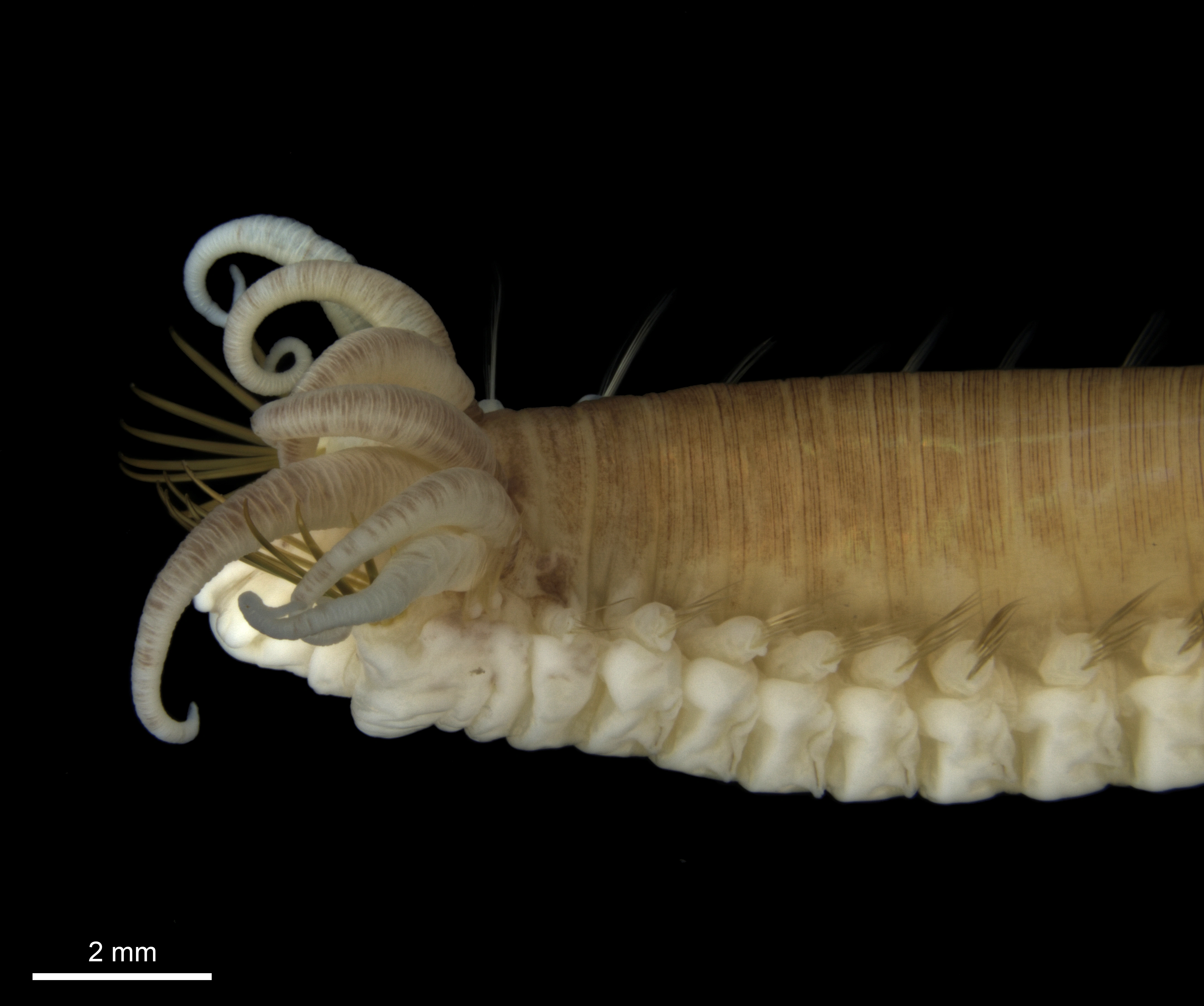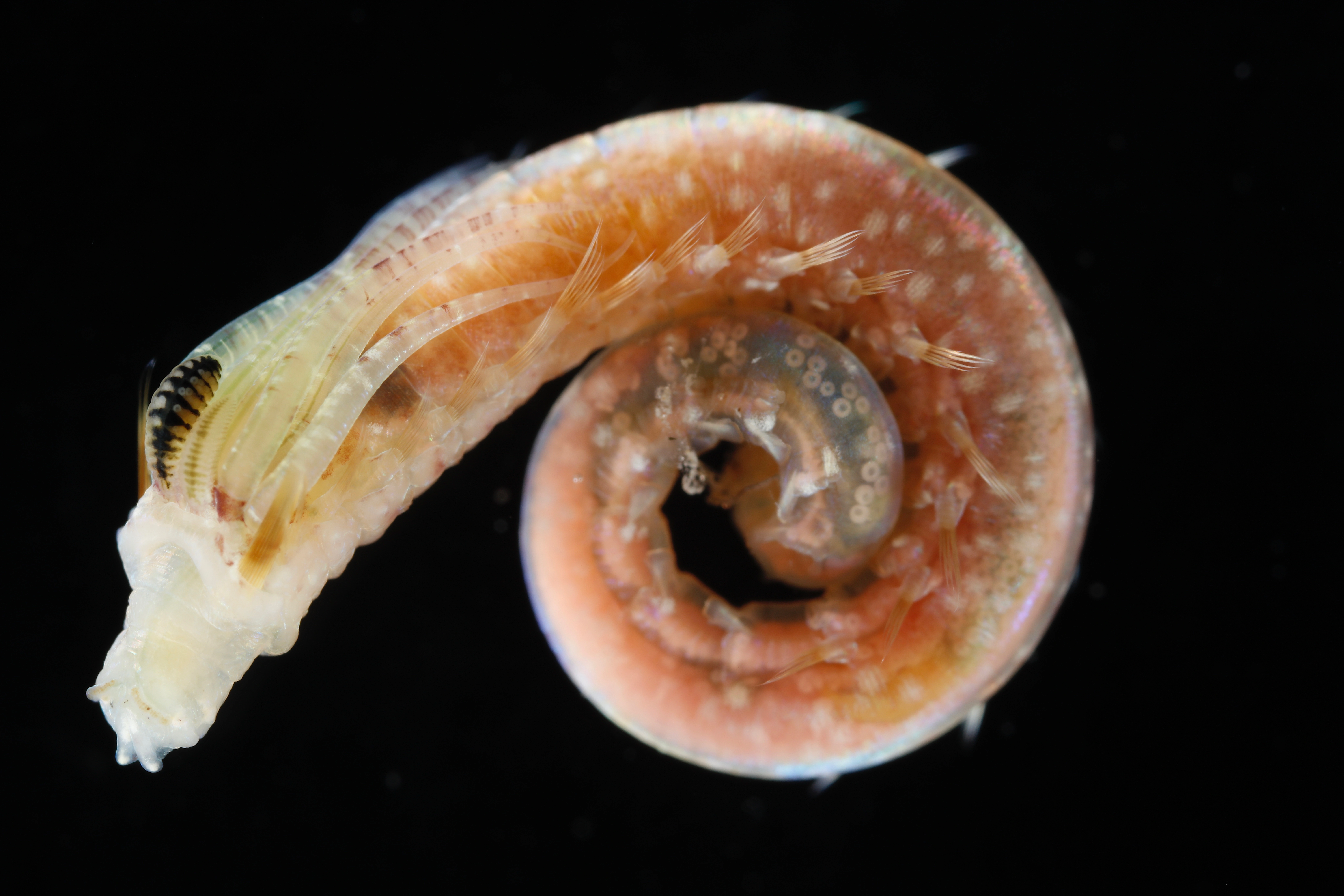Amphicteis gunneri
En Amphicteis gunneri fra Norskehavet.
Amphicteis gunneri can be up to 45 mm long. It can be found along the entire Norwegian coast and Svalbard at depths between 100 and 500 meters.
Type locality
Glesvær and Florø, Western Norway.
Key characters
Measurements: Up to 45 mm long.
Number of thoracic chaetigers, excluding paleae: 17
Number of thoracic uncinigers: 14
Number of abdominal uncinigers: 15
Prostomium: With longitudinal ridges and transverse nuchal grooves; numerous eyespots in front of nuchal organs.
Mouth tentacles: Smooth.
Branchiae: Four pairs of branchiae in two groups separated by distance equal to one branchial base diameter; the four branchiae in each group arranged in rhomboid pattern.
Paleae: Long with filiform tips; large specimens with close to 20 chaetae on each side.
Special features: All abdominal segments with rudimental notopodia.
Pygidium: With two long lateral cirri.
Tube: Thin layer of organic secretion incrusted with mud and with shell fragments attached.
Distribution
Entire Norwegian coast and Svalbard; 100–500 m.
Remarks
Amphicteis gunneri is reported to a have worldwide distribution (Holthe 1986a) and a wide depth range: from 15 m (Jirkov 2001) to 2613 m (Parapar et al. 2011). Although Schiaparelli & Jirkov (2016) refuted the cosmopolitan distribution of A. gunneri, it is still reported widely. Based on own observations and unpublished genetic data from Norwegian waters, A. gunneri does not occur deeper than 500 m (deep records in Holthe (1986a) are either A. ninonae or A. wesenbergae) and might consist of as many as four species.
Look-alikes
Three other species of Amphicteis: Amphicteis ninonae, Amphicteis sundevalli and Amphicteis wesenbergae occur in Norwegian waters and these might be confused with Amphicteis gunneri. Amphicteis ninonae has paleae with curved tips while A. gunneri has paleae with filiform tips. Amphicteis sundevalli has 18–20 abdominal uncinigers while A. gunneri has 15 abdominal uncinigers. Abdominal neuropodia have long dorsal cirri in Amphicteis wesenbergae while abdominal neuropodia have short dorsal cirri in A. gunneri.
Sources
Holthe T (1986a). Polychaeta Terebellomorpha. Marine Invertebrates of Scandinavia 7: 1-192.
Jirkov IA (2001). [Polychaeta of the Arctic Ocean] (In Russian). Polikhety severnogo Ledovitogo Okeana. Yanus-K Press. Moscow, 632 pp.
Parapar J, Helgason GV, Jirkov I, Moreira J (2011). Taxonomy and distribution of the genus Amphicteis (Polychaeta: Ampharetidae) collected by the BIOICE project in Icelandic waters. Journal of Natural History 45(23-24): 1477-1499. https://doi.org/10.1080/00222933.2011.558640
Sars M (1835). Beskrivelser og Iagttagelser over nogle moerkelige eller nye i Havet ved den Bergenske Kyst levende Dyr af Polypernes, Acalephernes, Radiaternes, Annelidernes og Molluskernes classer, med en kort Oversigt over de hidtil af Forfatteren sammesteds fundne Arter og deres Forekommen. Bergen, Thorstein Hallagers Forlag hos Chr. Dahl, R.S., xii + 81 pp., 15 plates. https://doi.org/10.5962/bhl.title.13017
Personal observations, Alvestad T.
En Amphcteis gunneri med en parasitt i slekten Calamyzas.
Siden siteres som:
Alvestad T og Budaeva N (2020). Amphicteis gunneri (M. Sars, 1835). www.artsdatabanken.no/Pages/299303. Nedlastet <dag/måned/år>



